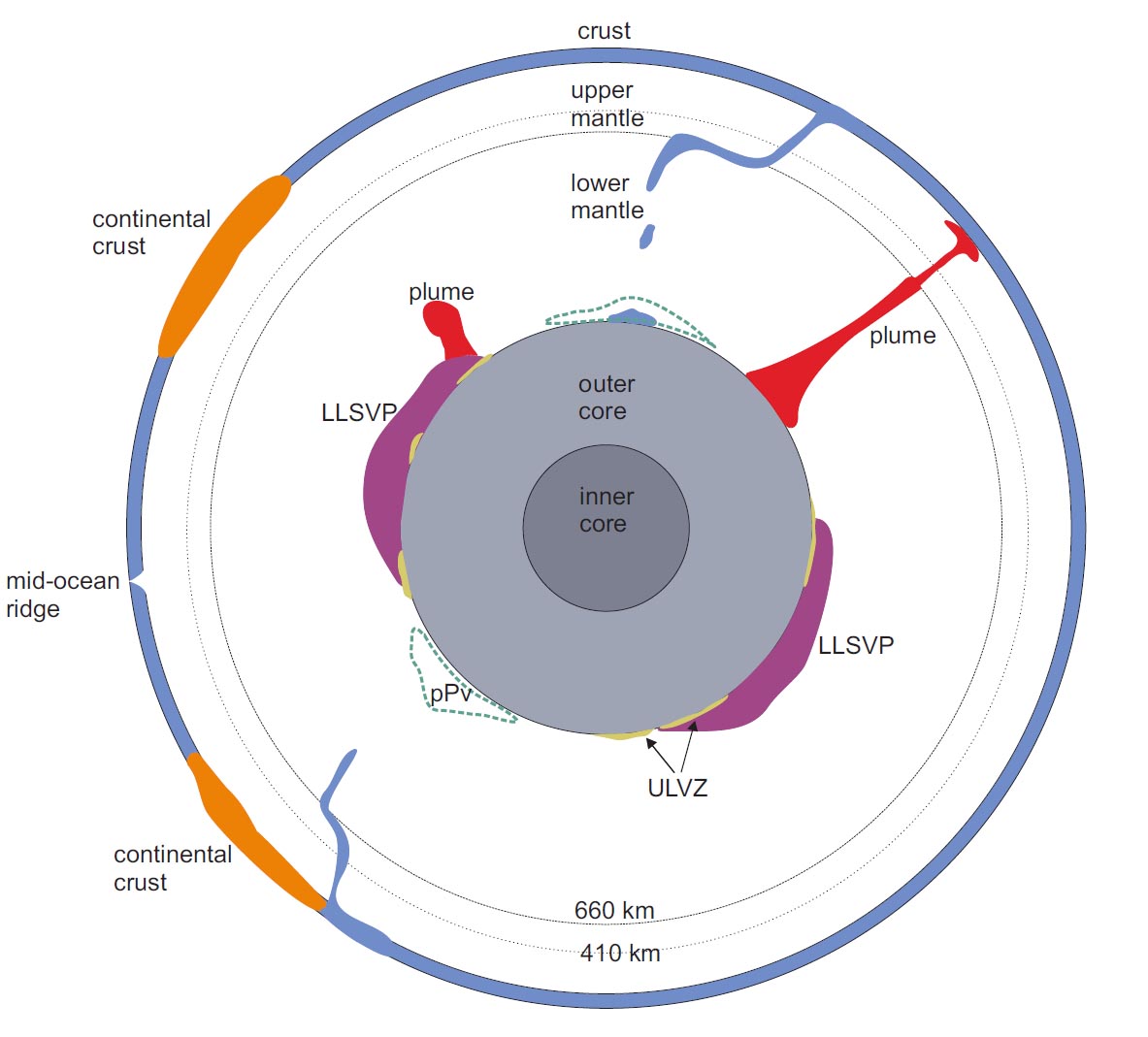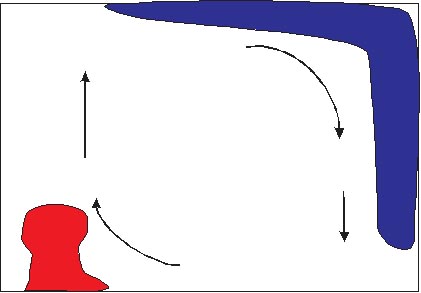The Earth
The Earth, our planet, is the third planet from the Sun and the only habitable planet in our solar system. The oldest material in the solar system is around 4.5 billion years old. Since the Earth was likely formed during the formation of the solar system, it is also 4.5 billion years old (Gya). After the Earth formed (accreted) it differentiated, meaning its interior separated into layers. The Earth’s interior is made of a spherical shells sort of like an onion. The radius of the Earth is 6371 km. It has an average density of 5.5 g/cm3.
Figure 1: Structure of the Earth's Interior

The structure of the Earth’s upper mantle can be derived from seismic waves. The main layers are the crust, the mantle and the core.
Let’s break them down into each section:
The Crust
The crust is the uppermost layer of the planet. It is between 5 and 80km thick. There are two types of crust, oceanic crust (found beneath the oceans) and continental crust. The oceanic crust is only 5-10km thick and made up mostly of basalt. The continental crust can be much thicker, up to 80km, and is made of less dense rocks such as silicate. The major element components of the crust are oxygen and silicon (Si) and thus the mantle is often referred to as the silicate mantle.
The Mantle
The mantle lies beneath the crust to a depth of about 2900km. The mantle has many layers within the upper and lower mantle. The upper layer is the lithosphere below which is the asthenosphere. The transition zone is the layer between the upper and lower mantle distinguished by the 410 km and 660 km discontinuities, as revealed by seismic evidence. The lower mantle has a D” layer just above the core-mantle boundary.
The Core
The Core is made up of two layers, the inner core and outer core. Seismic evidence tells us that the inner core is solid while the outer core is liquid. The inner core has a radius of 1 216 km and the total radius of the core is 3486 km. The core is composed mostly of iron (80%) and some nickel. The density of the inner ’solid’ core is between 9.9-12.2 g/cm3 and the outer core’s density is between 12.6-13 g/cm3.
It is through our study of the Earth that we can gain insight into the structure and composition of other planets. We also gather details from asteroids that fall to Earth from space. Using these asteroids we are able to learn about how the solar system looked when it was first forming. This helps us understand how the Earth and other planets looks when they were formed. By understanding what make up our planets, we can learn about why they behave in different ways.
The Dynamics of Earth
Convection is a term describing the flow of heat in a fluid that is driven by buoyancy derived from horizontal density gradients. Density gradients in the mantle are largely derived from horizontal temperature gradients (and also chemical/compositional horizontal gradients). In the thermal boundary layers (across which the temperature varies continuously from the surface value to the mean mantle temperature) this buoyancy causes instabilities, allowing fluid to leave the boundary layer and rise or fall throughout the system interior.
The mantle is a visco-elastic solid, meaning it behaves both viscously and elastically in response to a stress. The viscous nature of the mantle is evident in the slow creep of the mantle manifesting itself as plate tectonics on the surface of the Earth. The elastic nature of mantle rock is evident in the seafloor flexure around ocean island chains (e.g. Kearey, 2009). By assuming a fully elastic crustal layer overlying a fluid, the height of flexure in response to a load can be determined. These theoretical values can be compared with oceanic crust response to seafloor mounts to determine the elastic response of the mantle.
Heat is removed from the interior of a planet by thermal conduction as well as subsolidus convection. Subsolidus convection occurs from diffusion or dislocation creep in a solid material. The temperature difference between the interior and cooling surface of a planet maintains the thermal gradient necessary for convection.
Heat is the main source of energy driving convection in the mantle. Heat in the mantle is derived from internal sources (radioactive decay of the el- ements uranium, thorium and potassium), heat released from the core and secular cooling of the planet as a whole (residual heat left over from planetary formation and a higher production of radioactive heating in the past).
Mantle convection manifests itself at the surface of the Earth. Mid-ocean ridges correspond to the site of passive upwelling mantle material while ocean trenches correspond to the location of convective downwellings (subduction). The cycle of upwelling and downwelling convection helps recycle lithosphere into the mantle, producing new lithosphere at ridges and removing it at subduction zones. Figure 2 shows a depiction of a mantle convection cell, with a hot upwelling plume (red) and cold subducting slab (blue). Figure 1 shows a depiction of mantle convection with an upwelling plume, passive upwelling at a mid-ocean ridge and subducting slabs (downwellings). It also shows large-low shear velocity provinces, ultra-low-velocity-zones and areas of post-perovskite.
Figure 2: Convection cell in the mantle. Hot upwelling plume in red and cold downwelling (subducting) slab in blue.

The Earth’s top and bottom thermal boundary layers are influenced by strong chemical heterogeneity. Insert figure ‘convectioncell’ here The study of mantle convection is very important for understanding how the Earth functions, from how heat is lost from the interior to how the continental crust is replenished.
Mobile Lid Convection
Here we see a video of the type of mantle convection we expect to find inside the Earth, mobile-lid convection, where there is evidence of plate tec- tonics at the surface, with subduction, mid-ocean ridges and plumes within the mantle.
